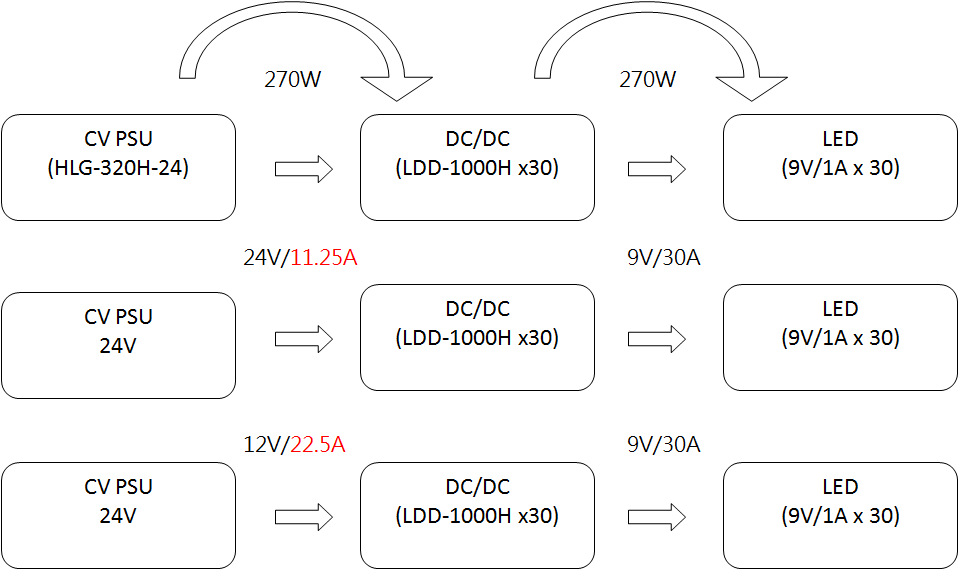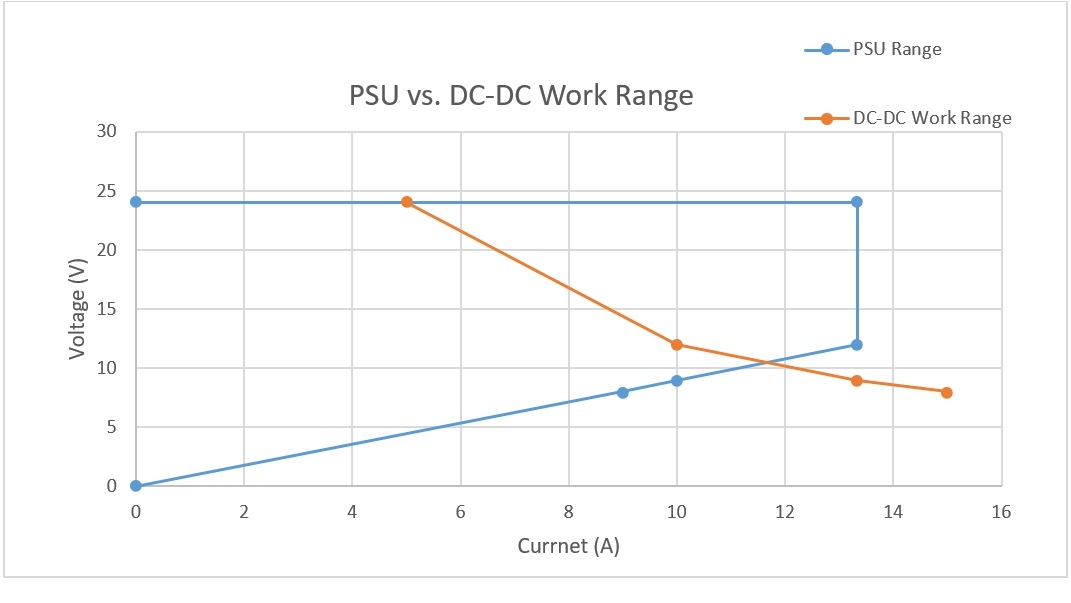Start Up Issue on LED modules with DC-to-DC Converter
By Hank Lan/MWEU Technical Dept.
hank@meanwell.eu
LED Driving Design StructureLED modules are typically driven by one of the three structures listed below:
- A constant current (CC) LED driver connects to LED directly, luminance controlled by LED driver’s output current.
- A constant voltage (CV) LED power supply, typically 12V or 24V, connects to LED strips or tubes which have resistor or simple current limiting circuit on the LED PCB. The resistor or current limiter defines the current and luminance.
- Cascade connection of a CV power supply and a DC-to-DC converter (DC/DC) and then to the LED board. The output current is controlled by the DC/DC converter only.
For the first two structures, power supplies are connecting to the LED without active conversion in between. The selection of power supply is relatively simple, either the right current or the right voltage should be selected. The third driving structure includes an active DC/DC in between which could bring certain compatibility concerns. In the following chapters, we will go through DC/DC working mechanism and potential problem when selecting a power supply with the wrong specification.
DC/DC converters have 3 types: Buck (step down conversion), Boost (step up conversion) and Buck-boost. No matter which converters they are, most of them have a wide operating range of input voltage. Within this input range, DC/DC converter will convert the input power to the desired output voltage and/or current to the load. If the load is fixed, the input power will also be fixed. Since the power is the same when input voltage is high, then input current will be low, and vice versa. Power conversion formula is shown below:

Off-the-shelf DC-driven LED tubes or spotlight normally contains such converters inside. On the manual of those products normally only a fixed input voltage is specified, e.g. “24VDC input”. When applying this voltage to the lamp, it will certainly work; however, the actual working range might be much wider and lower than this rated input voltage due to the DC/DC converter used inside.

Fig1. Track Lighting
To explain the phenomenon better, we take MEAN WELL LDD-350H DC/DC converter as an example. LDD-350H is a DC/DC converter that provides 350mA constant current to its load. The input voltage range is 9~56VDC, and the output range, which is related to LED forward voltage, is 2~52VDC. Since it is a step-down converter, the input voltage should be 3V higher than the output voltage according to the specification. This means, if the LED is 9V, LDD-350H can work at any of the input voltage between 12~56VDC. A lamp with this LED and converter built-in might very likely specify its input voltage as“24VDC input” as 24V power supply are commonly available in the market.

Fig2. LDD-H Specification
With insufficient information, the system installer might overlook the potential compatibility issue and suffer from startup failure such as blinking, darker light output, or simply no light at all. The issue is related to the transient response at power on and the behavior of DC/DC converter. More details are explained below:
Situation 1:
CV Power Supply Having Insufficient Current Under Low Output Voltage
A typical installation is illustrated in Fig.3. Each LDD-1000H with LED represents one LED tube. Assume LED is 9V, 1A, 30 of such LED tubes take 270W. If 24V input is indicated on the tubes, we might select HLG-320H-24 in this case, for example.

Fig. 3 CV Power Supply with 30 LED Tubes
HLG-320H-24 specification shows max. output power is 320.16W, and rated output current 13.34A. Apparently, using HLG-320H-24 on 24V/270W system is the right choice and even with a reasonable margin. However, the real situation is that LDD-1000H will start to work when input voltage is above 12V. If power supply has a relatively slow DC voltage rise time compare to DC/DC converter startup time, DC/DC might already turn to full power output before power supply’s output voltage rise to the right level. In such condition, since the input voltage is low, and DC/DC tries to still provide the full power to its load, it will take higher input current than expected, and eventually reaching and over the limit of HLG-320H-24. In this case, power supply output might be pull down to zero and restart itself, which causes the lamp either blinking, darker or simply cannot turn on. The calculation of input current depends on input voltage are shown as below:
- DC/DC converter input current when input voltage is 24V
- DC/DC converter input current when input voltage is 12V
*Neglecting non-ideal power loss, DC/DC converter requires two times higher current when input voltage is halved.


Fig. 5 HLG-320H Output Spec
CV Power Supply Output Voltage Not Running in the Operating Range
Fig. 6 shows another example with LDD-1000H, in this example LED is 6V and the total current is 20A. Since LDD-1000H is step-down converter, it will already start to work with input voltage between 6V to 9V. Again, if DC/DC converter turns to full power faster than CV power supply rise its output voltage level. DC/DC converter will try to work at low input voltage mode and get higher current from power supply. In this example below, if DC/DC start to work at 9V, the input current would reach HLG-320H-24 over current protection point. In such condition, power supply will stop rising its output voltage and stay in the constant current output mode. There is a chance that power supply and DC/DC converter could be stabilized at this abnormal but stable condition. However, for HLG-320H-24, the constant current region is 12~24V, and 9V is obviously lower than this range, thus power supply will enter hiccup mode. By chances, after several hiccup, power supply might finally enter workable range and lamp will be turn on ok in the end.

Fig. 6 If DC/DC start to provide full power before 9V, HLG-320H will enter hiccup mode due to low output voltage

Fig. 7 HLG-320H-24 Operating Range vs. DC/DC Converter operating line
From about two case studies, we could say the startup issues with DC/DC converter are majorly related to DC/DC converter actual working range. At low startup voltage, power supply might not work at the condition expected and thus create various startup problems.
Solution to Startup Issue
If a lamp has similar startup issue as mentioned above, here are some suggestions to try:
- Choosing a DC/DC converter with soft start or delay start feature
A DC/DC converter with soft start will increase its output power gradually to the right level after turning on. This helps to reduce DC/DC converter inrush current and can prevent startup failure from previous stage power supply. A delay start will not lower the inrush current, but since it only takes power when power supply voltage is ready, it can also prevent startup failure from mis-matched setup time.
- Using DC switch or dim off function on DC/DC converter if available
Switch on or release dim off only after power supply successfully establish the correct output voltage can avoid startup issue too. Normally the setup time of LED power supply is less than 0.5 seconds at 230VAC. Manually, disconnect the input power or postpones DC/ DC converter output for 0.5 seconds could avoid the startup issue too.

Fig. 8 Using DC Switch of dim off function on DC/DC converter
- Increase CV power supply output current rating
When output current is higher, it is less likely to encounter the power on lock up issue. To increase output current, it can be simply increase the power, e.g. changing HLG-320H-24 to HLG-480H-24, or change output voltage under the same power, e.g. changing from HLG-320H-24 (13.34A) to HLG-320H-12 (22A), as long as the selected voltage is within DC/DC converter working range, a lower voltage power supply can be selected.
- Contact with MEAN WELL for customized power solution
Some power supplies can provide peak power, and some power supplies can be modified with a more relaxed over-current protection to cover temporary current requirement. After power on, the average power should still within rated power of the power supply.
Summary
Compatibility issue is highly related to system requirement and conditions. When there is a startup issue on the LED lamp, it is suggested to check LED and DC/DC converter specification and consult with MEAN WELL power experts for further suggestions. MEAN WELL has a full range of LED power supplies from 8W to 1000W. With the system power solution, 25,000W or higher can be achieved. No matter it is a single LED lamp or a large-scale LED system, such as greenhouse luminaires, MEAN WELL has the right solution for all.
